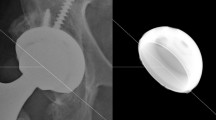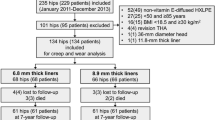Abstract
Purpose
Some data indicate that first-generation highly cross-linked polyethylene (HXLPE) can oxidise in vivo and is associated with reduced mechanical properties. To overcome these limitations, a natural anti-oxidant vitamin E has been added to HXLPE to preserve the mechanical properties and decrease oxidative degradation whilst conserving high wear resistance. We hypothesised that after a minimal three years of follow-up the use of vitamin E-blended HXLPE would result in lower radiographic wear when compared with ultra-high molecular weight polyethylene (UHMWPE).
Methods
One hundred patients were randomised to receive hybrid total hip arthroplasty (THA) using a monoblock cementless acetabular component made either of UHMWPE or vitamin E-blended HXLPE. All other parameters were identical in both groups. Complete follow-up was available for 74 of these patients. Femoral head penetration was measured using a validated computer-assisted method.
Results
The median creep measured 0.111 mm (range, −0.576 – +0.444 mm) in the vitamin E-blended group versus 0.170 mm (range, −0.861 – +0.884 mm) in the UHMWPE group (difference of medians, 0.059; p = 0.046). The median steady state penetration rate was −0.008 mm/year (range, −0.88 – +0.64 mm/year) in the vitamin E-blended group versus 0.133 mm/year (range, −0.84 – +0.85 mm/year) in the UHMWPE group (difference of medians 0.141, p = 0.043).
Conclusions
This study demonstrated that femoral head penetration was lower when using vitamin E-blended HXLPE when compared with UHMWPE, with a steady-state penetration rate far below the osteolysis threshold. Longer-term follow-up is needed to warrant whether wear reduction will generate less occurrence of osteolysis and aseptic loosening.

Similar content being viewed by others
References
Warth LC, Callaghan JJ, Liu SS et al (2014) Thirty-five-year results after Charnley total hip arthroplasty in patients less than fifty years old. A concise follow-up of previous reports. J Bone Joint Surg Am 96:1814–1819. doi:10.2106/JBJS.M.01573
Berry DJ, Harmsen WS, Cabanela ME, Morrey BF (2002) Twenty-five-year survivorship of two thousand consecutive primary Charnley total hip replacements: factors affecting survivorship of acetabular and femoral components. J Bone Joint Surg Am 84-A:171–177
Muratoglu OK, Bragdon CR, O’Connor DO et al (2001) A novel method of cross-linking ultra-high-molecular-weight polyethylene to improve wear, reduce oxidation, and retain mechanical properties. Recipient of the 1999 HAP Paul Award. J Arthroplasty 16:149–160. doi:10.1054/arth.2001.20540
Hopper RH, Huynh C, Ho H et al (2012) A prospective, randomized study of cross-linked and non-cross-linked polyethylene for total hip arthroplasty at 10-year follow-up. J Arthroplast 27:2–7.e1. doi:10.1016/j.arth.2012.03.048
Glyn-Jones S, Thomas GER, Garfjeld-Roberts P et al (2014) The John Charnley award: highly crosslinked polyethylene in total hip arthroplasty decreases long-term wear: a double-blind randomized trial. Clin Orthop Relat Res 473:432–438. doi:10.1007/s11999-014-3735-2
Langlois J, Atlan F, Scemama C et al (2015) A randomised controlled trial comparing highly cross-linked and contemporary annealed polyethylene after a minimal eight-year follow-up in total hip arthroplasty using cemented acetabular components. Bone Joint J 97-B:1458–1462. doi:10.1302/0301-620X.97B11.36219
Dumbleton JH, Manley MT, Edidin AA (2002) A literature review of the association between wear rate and osteolysis in total hip arthroplasty. J Arthroplasty 17:649–661
Wannomae KK, Bhattacharyya S, Freiberg A et al (2006) In vivo oxidation of retrieved cross-linked ultra-high-molecular-weight polyethylene acetabular components with residual free radicals. J Arthroplasty 21:1005–1011. doi:10.1016/j.arth.2005.07.019
Muratoglu OK, Wannomae KK, Rowell SL et al (2010) Ex vivo stability loss of irradiated and melted ultra-high molecular weight polyethylene. J Bone Joint Surg Am 92:2809–2816. doi:10.2106/JBJS.I.01017
Oral E, Rowell SL, Muratoglu OK (2006) The effect of alpha-tocopherol on the oxidation and free radical decay in irradiated UHMWPE. Biomaterials 27:5580–5587. doi:10.1016/j.biomaterials.2006.07.017
Rowell SL, Muratoglu OK (2016) Investigation of surgically retrieved, vitamin E-stabilized, crosslinked UHMWPE implants after short-term in vivo service. J Biomed Mater Res B Appl Biomater 104:1132-1140. doi:10.1002/jbm.b.33465
Salemyr M, Muren O, Ahl T et al (2015) Vitamin-E diffused highly cross-linked polyethylene liner compared to standard liners in total hip arthroplasty. A randomized, controlled trial. Int Orthop 39:1499–1505. doi:10.1007/s00264-015-2680-3
Shareghi B, Johanson P-E, Kärrholm J (2015) Femoral head penetration of vitamin E-infused highly cross-linked polyethylene liners: a randomized radiostereometric study of seventy hips followed for two years. J Bone Joint Surg Am 97:1366–1371. doi:10.2106/JBJS.N.00595
Martell JM, Berdia S (1997) Determination of polyethylene wear in total hip replacements with use of digital radiographs. J Bone Joint Surg Am 79:1635–1641
Bragdon CR, Martell JM, Estok DM et al (2005) A new approach for the Martell 3-D method of measuring polyethylene wear without requiring the cross-table lateral films. J Orthop Res 23:720–725. doi:10.1016/j.orthres.2004.07.008
Merle D’Augibné R (1970) Numerical evaluation of hip function. Rev Chir Orthop Reparatrice Appar Mot 56:481–486
Yan Y, Chen H, Feng J et al (2016) Poor performance of Enduron polyethylene liner in total hip arthroplasty: a minimum ten-year follow up and ultra-morphological analysis of wear particles. Int Orthop. doi:10.1007/s00264-016-3217-0
Kurtz SM, Gawel HA, Patel JD (2011) History and systematic review of wear and osteolysis outcomes for first-generation highly crosslinked polyethylene. Clin Orthop Relat Res 469:2262–2277. doi:10.1007/s11999-011-1872-4
Kuzyk PRT, Saccone M, Sprague S et al (2011) Cross-linked versus conventional polyethylene for total hip replacement: a meta-analysis of randomised controlled trials. J Bone Joint Surg (Br) 93:593–600. doi:10.1302/0301-620X.93B5.25908
Martell JM, Berkson E, Berger R, Jacobs J (2003) Comparison of two and three-dimensional computerized polyethylene wear analysis after total hip arthroplasty. J Bone Joint Surg Am 85-A:1111–1117
Ihle M, Mai S, Pfluger D, Siebert W (2008) The results of the titanium-coated RM acetabular component at 20 years: a long-term follow-up of an uncemented primary total hip replacement. J Bone Joint Surg (Br) 90:1284–1290. doi:10.1302/0301-620X.90B10.20274
Triclot P, Grosjean G, El Masri F et al (2007) A comparison of the penetration rate of two polyethylene acetabular liners of different levels of cross-linking. A prospective randomised trial. J Bone Joint Surg (Br) 89:1439–1445. doi:10.1302/0301-620X.89B11.19543
Digas G, Kärrholm J, Thanner J et al (2004) The Otto Aufranc Award. Highly cross-linked polyethylene in total hip arthroplasty: randomized evaluation of penetration rate in cemented and uncemented sockets using radiostereometric analysis. Clin Orthop Relat Res (429):6–16
Calvert GT, Devane PA, Fielden J et al (2009) A double-blind, prospective, randomized controlled trial comparing highly cross-linked and conventional polyethylene in primary total hip arthroplasty. J Arthroplasty 24:505–510. doi:10.1016/j.arth.2008.02.011
Röhrl S, Nivbrant B, Mingguo L, Hewitt B (2005) In vivo wear and migration of highly cross-linked polyethylene cups a radiostereometry analysis study. J Arthroplasty 20:409–413. doi:10.1016/j.arth.2004.09.040
Bracco P, Oral E (2010) Vitamin E-stabilized UHMWPE for total joint implants: a review. Clin Orthop Relat Res 469:2286–2293. doi:10.1007/s11999-010-1717-6
Author information
Authors and Affiliations
Corresponding author
Ethics declarations
Conflict of interest
One of the authors, or a member of his or her immediate family, has or may receive payments or benefits, during the study period, of an amount less than US$ 10,000, from Mahys AG (Bettlach, Switzerland)
Funding
There is no funding source
Ethical approval
This article does not contain any studies with human participants or animals performed by any of the authors
Informed consent
Informed consent was obtained from all individual participants included in the study
Additional information
Level of evidence
Level I therapeutic study
Rights and permissions
About this article
Cite this article
Scemama, C., Anract, P., Dumaine, V. et al. Does vitamin E-blended polyethylene reduce wear in primary total hip arthroplasty: a blinded randomised clinical trial. International Orthopaedics (SICOT) 41, 1113–1118 (2017). https://doi.org/10.1007/s00264-016-3320-2
Received:
Accepted:
Published:
Issue Date:
DOI: https://doi.org/10.1007/s00264-016-3320-2




